| |
Site Navigation
Main
News
Forums
Games
Games Database
Top 100
Release List
Support Files
Features
Reviews
Previews
Interviews
Editorials
Diaries
Misc
Download
Gallery
Music
Screenshots
Videos
Miscellaneous
Staff Members
Privacy Statement
|
|
A Tale in The Desert is a radically different massively multiplayer role-playing game. It contains no combat, no monsters, no player-killers, no swords or armor. Your character advances by completing, participating in, or leading large projects. Negotiation and politics play a very large role. The game has a plot that unfolds in response to player actions, and when the story is over, the game ends...

 Ever since UO and Meridian59 first came out, I've been hooked on MMORPG's. I remember the times treasure huntin' somewhere around Britain or slaughtering elves in Realm vs Realm combat in DAoC, while the first beams of morning sunlight peered through the windows again. The past couple of years, although I kept loving MMORPG's with all my heart, I felt something was missing. When I started playing AC2, I began wondering why these games actually used to appeal to me: they seemed to be nothing more than looking for a suitable mob spawn and camp it. Yes, we've seen the graphics evolve and we've seen some great new player vs. player features, but almost nothing has changed the basic gameplay formula of traditional MMORPG's: fight, loot and repeat. Until I heard about eGenesis' new MMORPG: A Tale in the Desert. A game without combat *gasp*. Ever since UO and Meridian59 first came out, I've been hooked on MMORPG's. I remember the times treasure huntin' somewhere around Britain or slaughtering elves in Realm vs Realm combat in DAoC, while the first beams of morning sunlight peered through the windows again. The past couple of years, although I kept loving MMORPG's with all my heart, I felt something was missing. When I started playing AC2, I began wondering why these games actually used to appeal to me: they seemed to be nothing more than looking for a suitable mob spawn and camp it. Yes, we've seen the graphics evolve and we've seen some great new player vs. player features, but almost nothing has changed the basic gameplay formula of traditional MMORPG's: fight, loot and repeat. Until I heard about eGenesis' new MMORPG: A Tale in the Desert. A game without combat *gasp*.
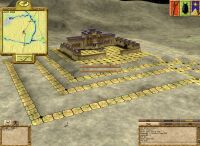 I've seen several reactions from veteran MMORPG players that sounded something like "Without combat? Phew, that's not an MMORPG!" or "Hah! How boring!" Of course, it doesn't sound as heroic to build your own pottery wheel and be able to make some jugs, as to slaughtering the enemy races and defending your keep with swords and magic. But that doesn't mean it's less fun, at least not for me. A Tale in the Desert is all about resource gathering, building, socializing and trading. It doesn't seem to be much, but believe me, ATITD is complicated enough to give you hands full of gameplay for months. Everything in this game is built around the Seven Disciplines of Man: Architecture, Leadership, Conflict, Arts, Warship, The Human Body and Thought. Only he who masters these Seven Disciplines, can acquire absolute human perfection. One must pass several tests to master a Discipline completely, including some challenging quests that require a lot of support of other players, talent for organization or art. Each of the Seven Disciplines has its own schools and universities spread out over Egypt. Schools offer the learning of skills to players, but require you to pay a tuition cost for every skill. When you've learnt the basic skills at schools, it's time to move on and start investing in research at universities. Technology moves rapidly forward and more complex skills from universities are needed in no time. Here you can donate resources for the research of new skills and once a skill becomes 'unlocked', everyone can learn it for free at that particular university. I've seen several reactions from veteran MMORPG players that sounded something like "Without combat? Phew, that's not an MMORPG!" or "Hah! How boring!" Of course, it doesn't sound as heroic to build your own pottery wheel and be able to make some jugs, as to slaughtering the enemy races and defending your keep with swords and magic. But that doesn't mean it's less fun, at least not for me. A Tale in the Desert is all about resource gathering, building, socializing and trading. It doesn't seem to be much, but believe me, ATITD is complicated enough to give you hands full of gameplay for months. Everything in this game is built around the Seven Disciplines of Man: Architecture, Leadership, Conflict, Arts, Warship, The Human Body and Thought. Only he who masters these Seven Disciplines, can acquire absolute human perfection. One must pass several tests to master a Discipline completely, including some challenging quests that require a lot of support of other players, talent for organization or art. Each of the Seven Disciplines has its own schools and universities spread out over Egypt. Schools offer the learning of skills to players, but require you to pay a tuition cost for every skill. When you've learnt the basic skills at schools, it's time to move on and start investing in research at universities. Technology moves rapidly forward and more complex skills from universities are needed in no time. Here you can donate resources for the research of new skills and once a skill becomes 'unlocked', everyone can learn it for free at that particular university.
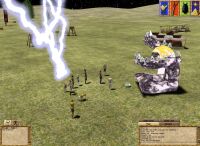 A Tale in the Desert takes place about 2500 years ago in Egypt, the country of pyramids and obelisks along the Nile. Instead of creating a virtual world and putting some players in it, eGenesis created a place and opportunity for players to create their own world. Except for the schools and universities, there are no towns or buildings that were not player-made. The ultimate goal is to create a perfect society, where everyone masters the Seven Disciplines and the interest of whole Egypt comes before personal gain. This is where the mean little tricks of the people at eGenesis come in... Although there is no violence and combat in the game, a lot of tests and technologies stimulate competition between players and guilds. Which guild will first unlock the skill of Glass Blowing at the University of Art? Will your sculpture gain more votes than others? Will you succeed in getting enough support for your leadership tests or will someone else run off with it? Then there's also The Stranger, some sort of metaphorical character used by the developers to make changes in the game world, sometimes by directly affecting players or guilds. Will The Stranger succeed in bringing corruption, egoism and competition in Egypt or will the players succeed in building their perfect society? That's the premise of the game. A Tale in the Desert takes place about 2500 years ago in Egypt, the country of pyramids and obelisks along the Nile. Instead of creating a virtual world and putting some players in it, eGenesis created a place and opportunity for players to create their own world. Except for the schools and universities, there are no towns or buildings that were not player-made. The ultimate goal is to create a perfect society, where everyone masters the Seven Disciplines and the interest of whole Egypt comes before personal gain. This is where the mean little tricks of the people at eGenesis come in... Although there is no violence and combat in the game, a lot of tests and technologies stimulate competition between players and guilds. Which guild will first unlock the skill of Glass Blowing at the University of Art? Will your sculpture gain more votes than others? Will you succeed in getting enough support for your leadership tests or will someone else run off with it? Then there's also The Stranger, some sort of metaphorical character used by the developers to make changes in the game world, sometimes by directly affecting players or guilds. Will The Stranger succeed in bringing corruption, egoism and competition in Egypt or will the players succeed in building their perfect society? That's the premise of the game.
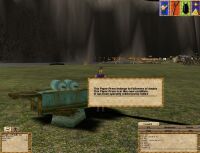 For once, you don't have to choose your race, class and stats before you enter the world: Everyone starts out equally. Stats like strength and endurance all start out with 0 and only start to play a significant role after a while. When setting off as a new player in ATitD, you're automatically being dropped off near one of the several Welcome Banners in the game. Instead of setting fixed spawn points for new players, eGenesis chose to let players create these spawn points themselves. Usually there's a mentor near such a welcome banner, an experienced player who guides newbies around, shows them the basic skills and teaches them how the principles work. In return, such a new player has the option to build a shrine for his mentor. Such a mentor needs 7 shrines to pass the mentorship test in the Discipline of Leadership. See how everything grips smoothly into each other, evading the traditional MMORPG pitfalls? One of the first things you'll have to learn is resource gathering, something that you'll probably keep doing all through the game. The first basic resources are pretty easy to obtain: to get straw, you just walk over to some grassland, gather grass by clicking a large button in the upper right corner and let it dry in the sun to produce the straw. Or to get slate you just have to walk along the shores of lakes or rivers and pick up slate whenever the slate-button in the corner appears on your screen. A lot of difficult and complex processes are based on these basic resources, however: the gameplay gets a lot more complex in no time. For once, you don't have to choose your race, class and stats before you enter the world: Everyone starts out equally. Stats like strength and endurance all start out with 0 and only start to play a significant role after a while. When setting off as a new player in ATitD, you're automatically being dropped off near one of the several Welcome Banners in the game. Instead of setting fixed spawn points for new players, eGenesis chose to let players create these spawn points themselves. Usually there's a mentor near such a welcome banner, an experienced player who guides newbies around, shows them the basic skills and teaches them how the principles work. In return, such a new player has the option to build a shrine for his mentor. Such a mentor needs 7 shrines to pass the mentorship test in the Discipline of Leadership. See how everything grips smoothly into each other, evading the traditional MMORPG pitfalls? One of the first things you'll have to learn is resource gathering, something that you'll probably keep doing all through the game. The first basic resources are pretty easy to obtain: to get straw, you just walk over to some grassland, gather grass by clicking a large button in the upper right corner and let it dry in the sun to produce the straw. Or to get slate you just have to walk along the shores of lakes or rivers and pick up slate whenever the slate-button in the corner appears on your screen. A lot of difficult and complex processes are based on these basic resources, however: the gameplay gets a lot more complex in no time.
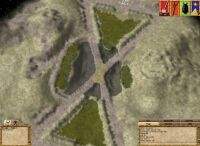 ATitD offers a complicated and unique tech tree never seen before in an MMORPG. It simulates a realistic virtual society evolving rapidly through all types of technology phases. Although the crafting of items might sound like a dull and boring activity, it often requires a lot of organization and sometimes teamwork. Take for example the production of clay jugs, used to carry water (needed for gathering clay or producing Flax): First you have to gather clay by digging in clay grounds after you softened the earth with water. Then you can turn the gathered clay into wet jug forms using pottery wheels. Those wet jugs then have to be baked in true kilns, for which you have to keep the fire burning by providing enough wood. After a while, you need to go through so many production steps that it gets almost impossible to handle it all on your own. And this was only one of the rather easy production techniques in the game. The higher the technology level gets, the more complicated the production becomes. Now what is the goal of all this crafting? It's not like we're playing a game to create some virtual furniture, right? First of all you need a lot of material to invest in research to unlock new technologies at universities. Then there's the products you need to pass tests or learn new skills, and last but not least there is the trading with other players and guilds. Of course, a lot of people wonder where the fun is in gathering grass or producing charcoal all the time... Actually, I wouldn't know. The only thing I know is that I enjoy doing it: The feeling of relief and pride when you finally achieved something big, the social contact, the evolving technology, ... even although the crafting and building is certainly not the only aspect of the game, I find it to offer me more challenging gameplay than the usual mob camping we know from games like EverQuest or DAoC. ATitD offers a complicated and unique tech tree never seen before in an MMORPG. It simulates a realistic virtual society evolving rapidly through all types of technology phases. Although the crafting of items might sound like a dull and boring activity, it often requires a lot of organization and sometimes teamwork. Take for example the production of clay jugs, used to carry water (needed for gathering clay or producing Flax): First you have to gather clay by digging in clay grounds after you softened the earth with water. Then you can turn the gathered clay into wet jug forms using pottery wheels. Those wet jugs then have to be baked in true kilns, for which you have to keep the fire burning by providing enough wood. After a while, you need to go through so many production steps that it gets almost impossible to handle it all on your own. And this was only one of the rather easy production techniques in the game. The higher the technology level gets, the more complicated the production becomes. Now what is the goal of all this crafting? It's not like we're playing a game to create some virtual furniture, right? First of all you need a lot of material to invest in research to unlock new technologies at universities. Then there's the products you need to pass tests or learn new skills, and last but not least there is the trading with other players and guilds. Of course, a lot of people wonder where the fun is in gathering grass or producing charcoal all the time... Actually, I wouldn't know. The only thing I know is that I enjoy doing it: The feeling of relief and pride when you finally achieved something big, the social contact, the evolving technology, ... even although the crafting and building is certainly not the only aspect of the game, I find it to offer me more challenging gameplay than the usual mob camping we know from games like EverQuest or DAoC.
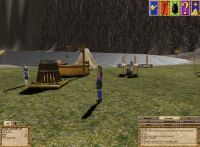 Although the gameplay certainly stands out in originality, A Tale in the Desert has some major flaws, too. One of them is definitely the sound and music... actually not the music but the complete absence of it. Although the basic sounds like footsteps are there, a lot of it is still missing that could add a lot to the general atmosphere of the game. The graphics in A Tale in the Desert are another rather difficult subject. The engine seems to be quite powerful and able to handle amazing detail levels but the general look of the game is fairly poor. The landscapes and the whole world are extremely flat and empty. Just some more random stones, trees, rocks, pools and more difference in ground textures would change a great deal to the looks. Also the ability to zoom out extremely far from your character diminishes the actual atmosphere of the environment in the game. Now that we're mentioning the negative aspects, we can as well go on and start raving about the sometimes too repetitive gameplay. The larger goals and achievements are fun, but after some time the basic processes like gathering grass or growing flax begin to be a real bore. If you don't have the courage or patience to work through all this, A Tale in the Desert is certainly not something for you. Although the gameplay certainly stands out in originality, A Tale in the Desert has some major flaws, too. One of them is definitely the sound and music... actually not the music but the complete absence of it. Although the basic sounds like footsteps are there, a lot of it is still missing that could add a lot to the general atmosphere of the game. The graphics in A Tale in the Desert are another rather difficult subject. The engine seems to be quite powerful and able to handle amazing detail levels but the general look of the game is fairly poor. The landscapes and the whole world are extremely flat and empty. Just some more random stones, trees, rocks, pools and more difference in ground textures would change a great deal to the looks. Also the ability to zoom out extremely far from your character diminishes the actual atmosphere of the environment in the game. Now that we're mentioning the negative aspects, we can as well go on and start raving about the sometimes too repetitive gameplay. The larger goals and achievements are fun, but after some time the basic processes like gathering grass or growing flax begin to be a real bore. If you don't have the courage or patience to work through all this, A Tale in the Desert is certainly not something for you.
Luckily, the tasks are numerous so you can switch between them. Also, as technology advances you'll find yourself doing less of the old repetetive tasks. For instance, when Brick Automation is researched you can build a brick machine that will create bricks for you. As technology moves forward you'll start gravitating towards more complex tasks and away from the old ones. Life as a newbie isn't exactly made easy either: Although the first steps in the game are carefully documented, there's a huge lack of more detailed information about a lot of aspects in the game. As a new player you are dependent on your fellow players for a great deal of help. You often have to discover many things yourself or go to one of the local fansites which have a great deal of information that was gathered during the betas of the game.
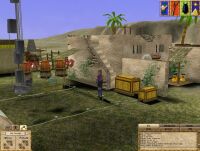 So, is A Tale in the Desert worth your money? Is it an enjoyable experience? It certainly is for me, but I can imagine it's not everyone's cup of tea. Although there are a lot of shortcomings that would prove fatal for the gameplay of any other MMORPG out there, ATitD offers a unique concept and a gameplay never seen before in any game, therefore it wouldn't be right to judge the game by these 'normal' standards. If you want to break away from the regular MMORPG tread mill, if you like social engagement, building up a community and researching new methods of crafting and products; then this game is what you're looking for. In a time when most mainstream MMORPG's seem to be copying each other, eGenesis created its own dream project that breaks away from everything you've ever seen before. Don't judge it before you played it. So, is A Tale in the Desert worth your money? Is it an enjoyable experience? It certainly is for me, but I can imagine it's not everyone's cup of tea. Although there are a lot of shortcomings that would prove fatal for the gameplay of any other MMORPG out there, ATitD offers a unique concept and a gameplay never seen before in any game, therefore it wouldn't be right to judge the game by these 'normal' standards. If you want to break away from the regular MMORPG tread mill, if you like social engagement, building up a community and researching new methods of crafting and products; then this game is what you're looking for. In a time when most mainstream MMORPG's seem to be copying each other, eGenesis created its own dream project that breaks away from everything you've ever seen before. Don't judge it before you played it.
|
The Verdict
|
Graphics (10%) |
81% |
 |
|
Sound (10%) |
63% |
|
Control (10%) |
85% |
|
Community (15%) |
96% |
|
Game World (15%) |
73% |
|
Fun (40%) |
93% |
|
Overall
|
85%
|
|
The ups and downs:
| Originality | Empty world | | Tech tree | Sound & Music | | Social contact | Sometimes too repetitive |
|
Reviewer's System
|
Version: |
1.0 |
|
CPU: |
AMD Athlon 1400MHz |
|
RAM: |
256MB |
|
Graphics |
GeForce 256 DDR |
|
Sound |
SB Live! |
|
OS: |
Windows XP |
|
Average Reader Ratings: 7.69 (35 votes) Rate this title and view comments Game Info Printer Friendly Version |
|











